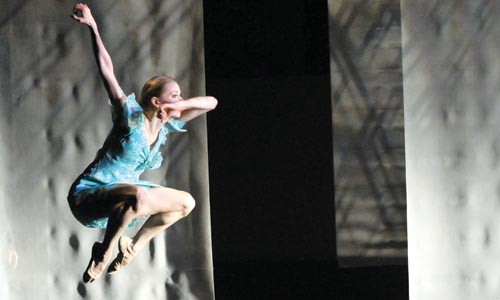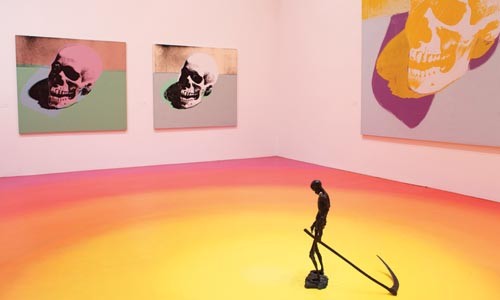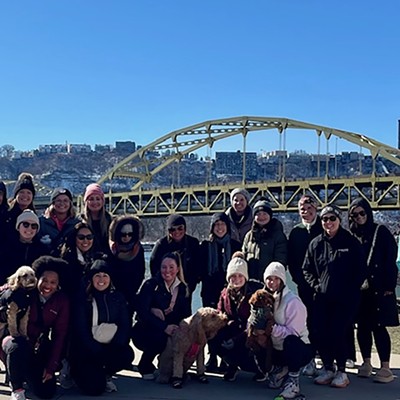Most Impressive Small Casts (According to CP theater critic Robert Isenberg)
When people think about theater, they tend to think big: huge sets, lavish costumes and scores of actors. If there isn't a giant chandelier falling from the ceiling or an army of French revolutionaries, what's the point of Broadway? But this year, Pittsburgh theaters proved the virtues of thinking small -- in this case, with tiny casts. Some of the best productions of the year featured no more than three actors onstage. This was all the more impressive when big-budget companies took chances on terse, intimate dramas.
Blackbird (City Theatre). A damaged man has an affair with an underage girl. Years later, just when he thinks he's paid for the crime, the girl returns as a young woman. Their awkward, tempestuous relationship stunned local audiences, and City should be commended for taking on David Harrower's difficult drama. Double props to Robin Abramson and Steve Pickering, for living up to such complex roles.
Breaking Up (No Name Players). Boy meets girl, boy and girl break up -- and then the sex really gets good. Michael Cristofer wrote Breaking Up back in the 1980s, but commitment phobias never get old. As performed by Tressa Glover and Jody O'Donnell, this breezy script became a lively relationship dramedy. Breaking Up continued No Name's tradition of hip, energetic theater.
Ella (Pittsburgh Public Theatre). There were a number of daring solo shows this year. Ella was not the best script or concept, but for sheer personality, Tina Fabrique stole all these shows as Ella Fitzgerald. Fabrique (and her backing band) filled the voluminous O'Reilly Theatre with her voice and liveliness.
Crime and Punishment (Pittsburgh Irish & Classical Theatre). My vote for the best production of the year goes to Crime, thanks to Curt Columbus' heartrending adaptation of Dostoyevsky's classic detective novel. Rarely has a trio appeared to have so much fun with such dreary content; set against a harsh industrial set, Larry John Meyers, Susan Goodwillie and Joel Ripka created an even coarser existential landscape. Running only 90 minutes, Crime left lasting impressions for those lucky enough to see it.
Doubt (Pittsburgh Irish & Classical). It takes chutzpah to produce a play when the movie version is circulating in national cineplexes. But PICT did just that, and Doubt was still an undoubted success. Meghan Heimbecker, Maria Becoates-Bey and the inimitable David Whalen starred in this Pittsburgh premiere of John Patrick Shanley's shattering drama.
Macbeth 3 (Unseam'd Shakespeare Co.). One of Shakespeare's greatest tragedies. Three actors. Cross-dressing. What more is there to say? Thanks to Lisa Ann Goldsmith, Rich Venezia and Jennifer Tober, Unseam'd Shakespeare wowed critics once again. Lisa Wolpe's wild adaptation also helped.
5 Shows That Helped Pittsburgh Survive Its Carnegie International Hangover
(According to CP art critic Curt Riegelnegg)
After a sprawling quadrennial art-glut rolls through town, with piggybacking shows peppering its neighborhoods, one might expect our modest burg to lean back and breathe. This list acknowledges those sites, curators and artists who powered through the morning after like men and women on a mission.
• Newly appointed Andy Warhol Museum curator Eric Shiner's debut, The End, scoffed at the recession-induced sizing-down at many major museums, pulling off an international survey that was understated and substantial. My favorites included Trevor Paglen's list, alphabetical and drily presented, of declassified U.S. military-operation code-names, and Raymond Pettibon's characteristically enigmatic ink drawing of a baseball player in the throes of self-doubt.
• Blending the work of burgeoning big fish like JD Walsh and Jacob Ciocci with a healthy dose of lesser-known local flavor, Smoke and Mirrors guided viewers through unfamiliar territory in video, sound, sculpture, painting and life-size cut-outs spewing vomit. The work, curated by Jesse Hulcher at Space Gallery, tended to be deceptively involved, hitting that sweet spot between challenging and approachable that's rare enough to warrant mention. (Disclosure: Space is operated by my employer, Wood Street Galleries.)
• Opera for a Small Room, at the Carnegie Museum of Art, was a fitting choice for a fatigued institution's day of rest and reflection. The eerie, compact installation, by Janet Cardiff and George Bures Miller, was really only a sort of decorated hovel (with audio, etc.). But in a stroke of curatorial cleverness, it was set square in the middle of an otherwise dark, barren and vast exhibition space. Thus it took advantage of the discomforting desolation of the abandoned home of Life on Mars to reinforce the artists' characterization of the hovel's reclusive, obsessive phantom occupant.
• In the second-to-latest installment of the Mattress Factory's Gestures series, Gestures 12, curator Katherine Talcott brought together a diverse crowd, mostly locals and not all self-described artists, to exploit the structural particulars of the museum's annex building. I found myself noting the tactility of the show, with even wispy fiber art or subtle robotics owning the space it was placed in.
• Carnegie Mellon's Miller Gallery continued its recent trends with Experimental Geography, drawing again from the well of intersecting cultural studies and social practices. This time, guest curator Nato Thompson assembled a show featuring exemplary feats of data-visualization, conceptual land-art and urban anthropology, to name a few, and impressively managed to glean a strong collective resonance out of the multidisciplinary hodgepodge.
8 Captivating Contemporary Dance Programs (According to CP dance writer Steve Sucato)
Three (Batsheva Dance Company at Pittsburgh Dance Council). One of the world's top contemporary dance companies, Israel-based choreographer Ohad Naharin's troupe presented a vision of natural beauty expressed in the "multi-dimensional" movement style he calls "Gaga" ... which is how it left audiences feeling.
Romeo et Juliette (Pittsburgh Ballet Theatre). An inspired choice by artistic director Terrence Orr, choreographer Jean-Christophe Maillot's re-envisioned Shakespearean masterwork fit PBT's dancers like a glove and showed what a talented and versatile group they are.
Passion Reflected (Attack Theatre). The troupe showed again why it's a local favorite in a program with works inspired by the Carnegie Museum of Art's Life on Mars exhibit and composer Manuel de Falla, along with a stellar collaboration with Los Angeles-based singer-songwriter Katie Costello.
The Rite of Spring/Prelude to Afternoon of a Faun (Compagnie Marie Chouinard at Pittsburgh Dance Council). Two of the Montreal-based company's most beloved works, the program showcased Chouinard's brilliantly quirky choreographic interpretation of the Nijinsky classics.
Exposed (Dance Alloy Theater). What turned out to be artistic director Beth Corning's final production for the company exposed area audiences to the work of acclaimed choreographer Nora Chipaumire. Her "Becoming Angels" was a striking play on inner religious fervor. The program also featured Corning's touching life-sized puppet drama "4-2 Men."
newMoves Contemporary Dance Festival (Kelly-Strayhorn Theater). The brainchild of Kelly-Strayhorn executive director Janera Solomon, the four-day festival presented an eclectic mix of works from local artists alongside visitors from New York and Philadelphia. The (hopefully) annual festival fills a "big city" void Pittsburgh has sorely been lacking.

Light/The Holocaust and Humanity Project (Pittsburgh Ballet Theatre). A milestone for the PBT's 40th season, choreographer Stephen Mills' Holocaust-themed work was gripping, disturbing and the stuff great dance theater is made of. PBT's interpretation was memorable.
The Bench (Point Park University Conservatory Dance Company). Choreographer Kiesha Lalama-White's evening-length, family-themed contemporary jazz work was solidly constructed, with a marvelous original jazz score. The December production was adroitly danced by CDC's student dancers, and fittingly closed out 2009 with a bang.
Three We'll Miss in 2010 (According to CP arts editor Bill O'Driscoll)
International Poetry Forum. In its astounding 43 seasons, Samuel Hazo's series has brought to town too many world-renowned poets to list, from W.H. Auden and Gwendolyn Brooks to W.S. Merwin. But this year the funding couldn't be found, and an April 14 reading by Adam Zagajewski was the last.
Open Stage Theater. Small theater companies always struggle, but OST lost its lease and began an indefinite hiatus. The season that closed with the premiere of Amy Hartman's unnerving dark comedy Disinfecting Edwin was proof that little troupes can make big artistic contributions.
moxie DaDA. The little North Side gallery didn't vanish so much as elope into cyberspace. But we'll miss its well-curated shows, often featuring cutting-edge work by local artists.
















